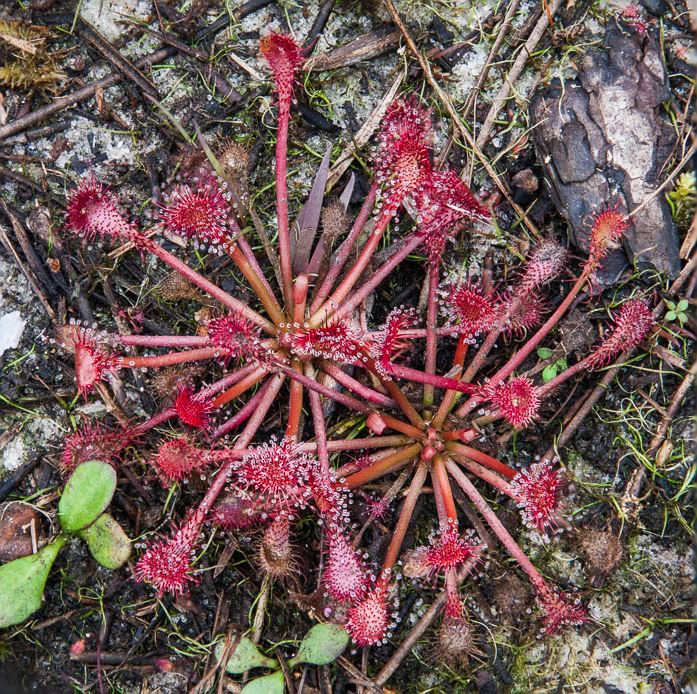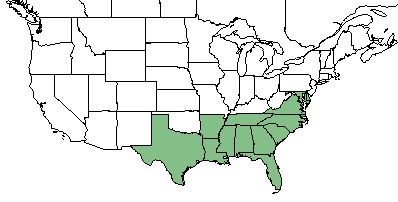Difference between revisions of "Drosera capillaris"
(→Ecology) |
|||
| Line 36: | Line 36: | ||
<!--===Seed bank and germination===--> | <!--===Seed bank and germination===--> | ||
===Fire ecology=== <!--Fire tolerance, fire dependence, adaptive fire responses--> | ===Fire ecology=== <!--Fire tolerance, fire dependence, adaptive fire responses--> | ||
| − | The occurrence of fires within the previous year has shown to significantly reduce the proportion of flowering rosettes by half.<ref name="Brewer 1999">Brewer J. S. (1999). Effects of fire, competition and soil disturbances on regeneration of a carnivorous plant (''Drosera capillaris''). American Midland Naturalist 141:28-42.</ref> Burns during the months of May and August produced similar levels of mortality which primarily were caused by burial and shifting sediment related to crayfish chimneys.<ref name="Brewer 1999"/> | + | The occurrence of fires within the previous year has shown to significantly reduce the proportion of flowering rosettes by half.<ref name="Brewer 1999">Brewer J. S. (1999). Effects of fire, competition and soil disturbances on regeneration of a carnivorous plant (''Drosera capillaris''). American Midland Naturalist 141:28-42.</ref> Burns during the months of May and August produced similar levels of mortality which primarily were caused by burial and shifting sediment related to crayfish chimneys.<ref name="Brewer 1999"/> Such findings suggest fire and carnivory may allow the rapid growth and establishment of ''D. capillaris'' in nutrient poor wet savannas.<ref name="Brewer 1999"/> |
<!--===Pollination===--> | <!--===Pollination===--> | ||
<!--===Use by animals===--> <!--Herbivory, granivory, insect hosting, etc.--> | <!--===Use by animals===--> <!--Herbivory, granivory, insect hosting, etc.--> | ||
Revision as of 14:43, 6 December 2017
| Drosera capillaris | |
|---|---|

| |
| Photo by John B | |
| Scientific classification | |
| Kingdom: | Plantae |
| Division: | Magnoliophyta - Flowering plants |
| Class: | Magnoliopsida - Dicots |
| Order: | Nephenthales |
| Family: | Droseraceae |
| Genus: | Drosera |
| Species: | D. capillaris |
| Binomial name | |
| Drosera capillaris Poir. | |

| |
| Natural range of Drosera capillaris from USDA NRCS Plants Database. | |
Common Name(s): pink sundew[1][2]
Contents
Taxonomic Notes
Synonym(s): D. rotundifolia var. capillaris, D. sessilifolia, D. brevifolia var. major, D. minor, D. tenella[3]
Description
D. capillaris is a dioecious perennial forb/herb.[2]
Distribution
Drosera capillaris is found in the southeastern United States ranging from Virginia, south to Florida, and westward to Texas. It can aslo be found in the West Indies, Mexico, and northern South America.[1]
Ecology
Habitat
It is an obligate wetland species[2] being found in pine savannas and other wet sandy or peaty soils.[1]
Fire ecology
The occurrence of fires within the previous year has shown to significantly reduce the proportion of flowering rosettes by half.[4] Burns during the months of May and August produced similar levels of mortality which primarily were caused by burial and shifting sediment related to crayfish chimneys.[4] Such findings suggest fire and carnivory may allow the rapid growth and establishment of D. capillaris in nutrient poor wet savannas.[4]
Conservation and Management
Cultivation and restoration
Photo Gallery
References and notes
- ↑ 1.0 1.1 1.2 Weakley A. S.(2015). Flora of the Southern and Mid-Atlantic States. Chapel Hill, NC: University of North Carolina Herbarium.
- ↑ 2.0 2.1 2.2 USDA, NRCS. (2016). The PLANTS Database (http://plants.usda.gov, 30 November 2017). National Plant Data Team, Greensboro, NC 27401-4901 USA.
- ↑ Wunderlin R. P., Hansen B. F., Franck A. R. and Essig. F. B. (2017). Atlas of Florida Plants (http://florida.plantatlas.usf.edu/).[S. M. Landry and K. N. Campbell (application development), USF Water Institute.] Institute for Systematic Botany, University of South Florida, Tampa.
- ↑ 4.0 4.1 4.2 Brewer J. S. (1999). Effects of fire, competition and soil disturbances on regeneration of a carnivorous plant (Drosera capillaris). American Midland Naturalist 141:28-42.